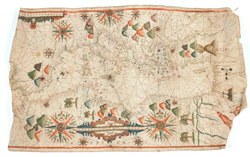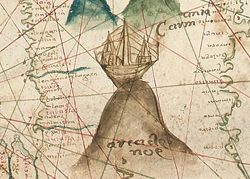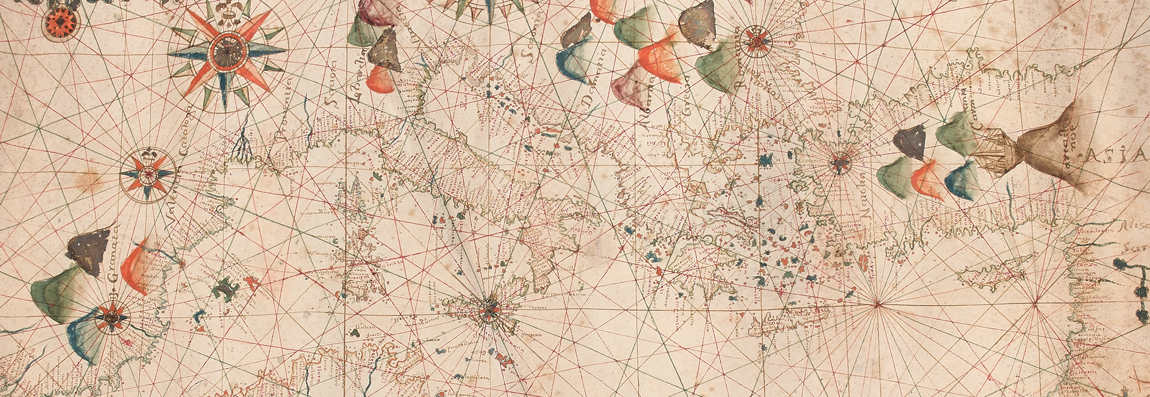Vente aux enchères Portulan de la Méditerranée.
PLACIDO CALOIRO et OLIVA [atelier de].
[Portulan de la Méditerranée]. Messine, entre 1621 et 1665. 71,5 x 44,5 cm.
Carte-portulan enluminée sur vélin représentant le bassin méditerranéen. Les éléments décoratifs ainsi que les archipels sont coloriés en bleu, vert et rouge. Les noms des villes et localités côtières, très serrés, sont tracés à l'encre rouge ou bistre ; ceux des régions et des États, de plus grand format, à l'encre bistre. Les fleuves sont tracés en bleu. Le portulan est abondamment orné, notamment de 2 grandes roses des vents, d’une demi-rose ainsi que de 13 roses de plus petit format. Une magnifique échelle ornée de 22 cm est inscrite à l’intérieur de l’Afrique du Nord.
De nombreuses montagnes, représentées schématiquement, ornent la carte ainsi que quelques palmiers en Afrique du Nord. Au levant, trois lieux spécifiques sont figurés : le Monastère de Ste-Catherine, le Mont Calvaire avec 3 croix et le fleuve Jordan.
Mais la représentation la plus inhabituelle est celle localisée en Anatolie : l’Arche de Noé au sommet du Mont Ararat. Manque de vélin d’environ 30 cm de large dans la partie occidentale du portulan et manque de quelques millimètres à droite de la partie orientale avec une perte plus importante dans l’angle inférieur. En dehors de ces défauts, le portulan est en bon état, les coloris sont demeurés vifs et les tracés nets.
Estimation Euros 5.000 – 8.000
Résultat : 22.000.00
 Cartographiquement ce portulan est typique de la production du milieu du 17e
siècle, que ce soit par l’étendue de la région représentée que par le peu de
détails figurés à l’intérieur des terres. Pendant des siècles précédant la
production de cette carte, la plupart des cartes nautiques présentaient une
rotation d’environ 9° dans le sens contraire des aiguilles d’une montre afférente à la
déclinaison magnétique en Méditerranée. Bien qu’au milieu du 17e siècle certains
cartographes aient identifié le décalage et indiqué la vraie route géographique,
l’auteur de cette carte a choisi de suivre le modèle traditionnel de rotation.
Cartographiquement ce portulan est typique de la production du milieu du 17e
siècle, que ce soit par l’étendue de la région représentée que par le peu de
détails figurés à l’intérieur des terres. Pendant des siècles précédant la
production de cette carte, la plupart des cartes nautiques présentaient une
rotation d’environ 9° dans le sens contraire des aiguilles d’une montre afférente à la
déclinaison magnétique en Méditerranée. Bien qu’au milieu du 17e siècle certains
cartographes aient identifié le décalage et indiqué la vraie route géographique,
l’auteur de cette carte a choisi de suivre le modèle traditionnel de rotation.
Une anomalie est à noter en Mer Noire. Seul le quart sud-ouest de la mer est
figuré, alors que, sur une carte de cette époque, on s’attend à voir figurer la
totalité de la mer. De même la représentation de la Crimée est plutôt schématique
alors que des relevés beaucoup plus précis étaient accessibles aux cartographes de
l’époque. On peut seulement spéculer sur les raisons de cette représentation. Il se
peut que cette carte ait été commandée par un Capitaine dont le commerce se limitait
à la Mer Méditerranée et aux mers adjacentes.
Le système de 32 lignes de rhumb centré ici sur la Sicile, coïncide avec la
patrie de Placido Caloiro et Oliva, a qui est attribué ce portulan.
Attribution :
Cette carte a été étudiée par Monsieur Richard Pflederer, spécialiste reconnu
en histoire de la cartographie et plus spécifiquement dans le domaine des
cartes-portulans.
Une majorité de cartes-portulans portent le nom de leur auteur et une date.
La carte présentée ne porte aucune indication mais il est fort probable que
ces informations étaient inscrites sur la partie occidentale manquante.
Cependant le portulan montre de nombreuses similitudes avec l’œuvre de
Placido Caloiro et Oliva. La comparaison avec 5 cartes connues comme étant
de sa main, fait apparaître plus de 20 points de concordance, que ce soit du
point de vue cartographique ou de la décoration. Les zones spécifiquement
étudiées sont le Détroit de Gibraltar, la Sicile, Chypre et la Crète ainsi
que le tracé côtier de l’Afrique du Nord. En outre, l’échelle ornée, les roses
des vents, les palmiers, le Mont Calvaire et la représentation schématique de la
rivière Jordan, correspondent parfaitement au travail de Placido Caloiro et Oliva.
De même le tracé et la forme de l’embouchure de fleuves importants comme le Nil
ou le Rhône, sont similaires à ceux de Placido Caloiro et Oliva.
Cependant cette carte présente quelques différences avec la production de Placido
Caloiro et Oliva. La plupart des cartes produites par celui-ci comprennent une
vingtaine de vignettes figurant des villes, cette carte n’en possède aucune. D’autres
cartes de sa main figurent des soldats et des animaux, celle-ci est vierge de ces
représentations. Enfin le tracé des côtes et le graphisme des noms de lieu ne semblent
pas aussi précis que sur ses autres cartes. Cependant certaines différences notables
peuvent apparaître au cours d’une carrière couvrant plus de 40 ans d’activité.
Quoi qu’il en soit, l’attribution à l’atelier de Placido Caloiro et Oliva se
justifie largement et une attribution à Placido Caloiro et Oliva, lui-même, est crédible.
On peut en déduire que la date de production de cette carte se situe entre 1621 et 1665.
Famille Caloiro et Oliva.
Cette famille est apparemment une branche de la famille Oliva qui inclut une douzaine de
cartographes à avoir signé cartes marines et atlas entre 1538 et 1673. La forme du
patronyme varie selon les décades et les siècles, en fonction du lieu d’activité de
l’atelier. On trouve les formes suivantes : « Oliva », « Ollive », Ollives »,
« Olivo » ainsi que « Caloiro et Oliva ». Trois membres de la famille Caloiro et
Oliva, ont signé des cartes entre 1621 et 1665, mais la majorité d’entre elles
(32 cartes) sont signées par Placido entre 1621 et 1673. Cinq autres
cartes-portulans/atlas lui sont également attribuées. Alors que beaucoup
de membres de la famille Oliva ont déplacé leur activité dans huit différents
ports, passant par Messine, Barcelone et Venise, toutes les productions de Placido
sont signées à Messine.
Analysis of a Portolan Chart of the 17th century
Richard Pflederer (January 21, 2019)
Description
Manuscript sea chart pen and ink drawn on vellum measuring 71.5 x 44.5 cm. elaborately
decorated in the traditional style of portolan charts. In very good condition except
for two sections where the vellum is missing. On the western edge, a strip about 30
cm wide has been lost and in the southeast a small section of the corner has been
torn away. Despite these losses, the actual coverage area of the chart has not been
significantly impacted.
Cartographically, the chart is very typical for charts of the mid-17th century,
including the extent of the coverage area, and the minimal depiction of details
within the land masses. For centuries preceding the production of this chart most
charts exhibited the distinctive counterclockwise rotation of about 9°, presumably
related to the magnetic declination in the Mediterranean. Although by the mid-17th
century some cartographers were recognizing this discrepancy and drawing charts to
true geographical directions, the chart maker of this chart chose to follow the
traditional pattern, and thus the rotation is observed. The center of the hidden
circle from which the 32 primary rhumb lines radiate is located in Sicily.
Decorative elements
The chart is heavily decorated with most of the interior of landmasses covered by
decorative devices. There are two large compass roses as well as a large half compass
rose and several smaller ones. But the element which dominates the interior of North
Africa is an elaborately embellished scale bar about 22 cm long. Next in importance
are the numerous schematically represented mountains, and also several palm trees in
Africa. In the Levante there are depictions of three specific locations: the Monastery
of St. Catherine, Mount Calvary with three crosses and the River Jordan. But possibly
the most unusual is found in Anatolia: Noah’s Arc resting atop Mt. Ararat.
 A detail showing Noah’s Arc resting on the top of Mount Ararat in Anatolia. This is a
very unusual drawing whose Old Testament reference complements the New Testament
depiction of Mount Calvary with its three crosses in Palestine.
A detail showing Noah’s Arc resting on the top of Mount Ararat in Anatolia. This is a
very unusual drawing whose Old Testament reference complements the New Testament
depiction of Mount Calvary with its three crosses in Palestine.
Cartographic considerations
By the mid-17th century, the cartographic content of Mediterranean Sea charts was
firmly established with very little opportunity or need for continuing evolution.
And this chart is no exception. The shape of the coastlines was well known and the
conventions for depicting navigational hazards established. As noted above the system
of 32 radiating rhumb lines is centered on Sicily, coincidently very near the home
of the author to whom we are attributing the chart.
At each of sixteen points where the radiating lines intersect the hidden circle, a secondary node is formed from which another 32 rhumb lines radiate. At fourteen of these sixteen nodes, the author has placed a compass rose, so the navigator was well equipped with lines from which to plot his course.
One notable anomaly is the treatment of the Black Sea. First, only the southwestern quadrant of the sea is included whereas in most charts of the period, we would expect to see the entire sea. Second, depiction of Crimea is almost schematic rather than the more finely dawn coastlines which were available to cartographers in this period. We can only speculate on the reasons for this treatment, but one possibility is that the chart was produced on commission for a captain whose business was limited to the waters of the Mediterranean and other adjacent seas.
The 9° rotation of the charts versus true geographic directions at first glance might seem to present navigational problems. However, in the period compasses were not corrected for magnetic declination, so ships were typically sailed to magnetic courses which were roughly equal to the directions extracted from the charts. And so, the directional errors in the chart were largely offset by the variation in the compasses.
Authorship
A majority of portolan charts bear an inscription with the author’s name and the date.
No inscription is present on this chart, but there likely was one on the now-missing
western part of the chart. However, after searching for similar charts within the
indicated timeframe, a very strong resemblance to the works of Placido Caloiro et
Oliva was noted. A comparison with five charts known to be the work of this author
revealed excellent correspondence on over twenty different cartographic and decorative
reference points.
The cartographic areas analyzed include depictions of specific
geographical areas such as the Strait of Gibraltar, the islands of Sicily, Cyprus
and Crete as well as the coastline of North Africa. Similarly, for decorative elements,
the large scale bar and compass roses, the palm trees, Mount Calvary and the schematic
River Jordan all match perfectly with the works of Placido Caloiro et Oliva. The form
and shape of the mouths of major rivers such as the Nile and the Rhone also match the
charts of Caloiro et Oliva.
However, some differences are noted. Most of the charts known to be drawn by Caloiro et
Oliva have as many as 20 town vignettes while the present chart has none. Others signed
by this author have images of soldiers and animals while this chart has none. Finally,
the drawing of the coastlines and the writing of the placenames on this chart do not
seem to be executed as precisely on some of his other charts. However, with a career
spanning some four decades, some significant variation is to be expected.
Nonetheless, an attribution to the workshop of Placido Caloiro et Oliva is fully
justified and an attribution to Placido himself is credible. This would put the date
of production somewhere between 1621 and 1665.
A few comments on the Caloiro et Oliva family
This family is apparently a branch of the Oliva family which includes over a dozen
cartographers who signed charts and atlases between 1538 and 1673. The form of the
surnames varied over the decades and centuries, particularly depending on where the
business was located at the time. We see ‘Oliva’, ‘Ollive’, ‘Ollives’, ‘Olivo’ as
well as ‘Caloiro et Oliva’. Three members of the Caloiro et Oliva branch of the
family signed charts between 1621 and 1673, but with the majority of these (32 items)
were signed by Placido between 1621 and 1665. There are also another five charts/atlases
attributed to him. It is interesting that while many of the Oliva family moved between
eight different ports ranging from Messina to Barcelona to Venice, all of Placido’s
works are signed in Messina.
 About the author
About the author
Richard Pflederer is a noted researcher in the History of Cartography whose recent
focus has been portolan chart and atlases. These are manuscript sea charts which were drawn
on vellum for over four hundred years beginning at the end of the 13th century.
His latest project, Finding their Way at Sea (release date October 2012) is a richly
illustrated book intended for a general audience. It tells the story of portolan charts
from a human point of view, focusing on the cartographers who drew the charts, the mariners
who sailed by them and their destinations in the Med Sea and around the world.
He is the author of five detailed catalogues of major collections in the US and England,
including the British Library (London), the Bodleian Library (Oxford), the National
Maritime Museum (Greenwich), the Huntington Library (San Marino) and the Newberry Library
(Chicago). In addition to these catalogues he is the author of a definitive and
comprehensive census of all known surviving charts and atlases.
He also lectures extensively on this and other cartographic subjects at international
venues including Verona, London, Greenwich, Vienna, Guatemala City, Washington and Chicago.
He is a Fellow of the Royal Geographical Society, a member of the International Map
Collectors Society, the Editorial Advisory Board of the Journal of the Washington Map
Society and the Society for the History of Discoveries. In 2010 he founded the
Williamsburg Map Circle. He is a lecturer at the Christopher Wren Association of
the College of William & Mary, and a member of the adjunct faculty of Old Dominion
University.
He and his wife, Sue, share their time between Williamsburg, Virginia and Montepulciano, Tuscany.

